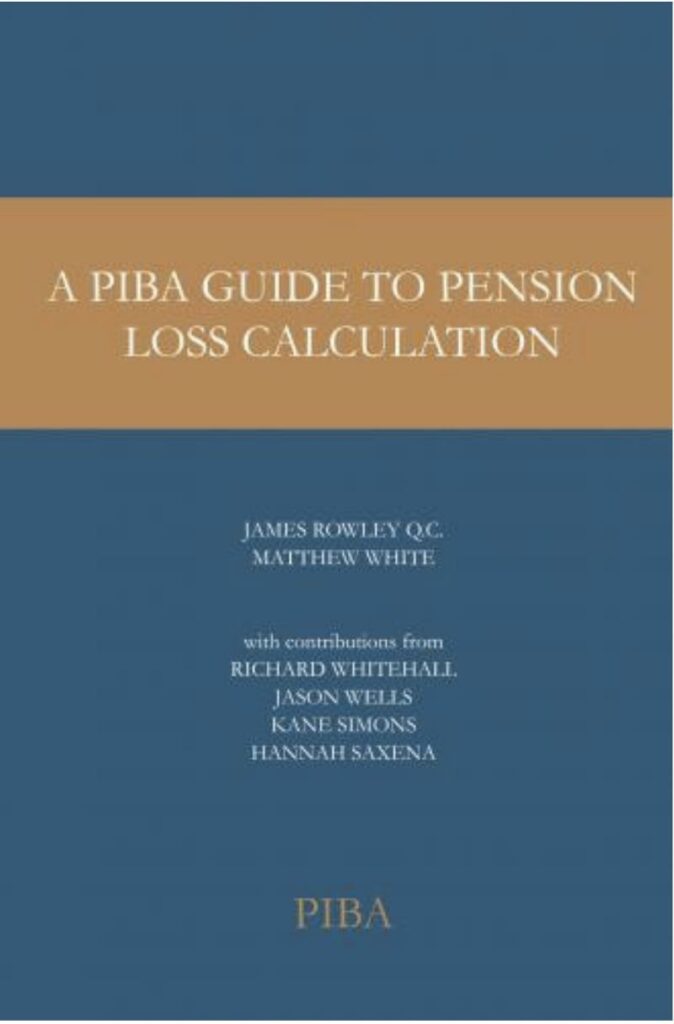
Find Barrister by Expertise:
- View All
- Personal Injury
- Travel & International Law
- Civil Fraud
- Employment
- Crime & Criminal Fraud
- Health & Safety
- Clinical Negligence
- Regulatory & Disciplinary
- Property Damage
- Inquests
- General Common Law
- Industrial Disease
- Insurance
- Sports Law
- Credit Hire
- Professional Negligence
- Public Inquiries
- Public Law
- Trusts & Probate
- Costs
- Mediation & Arbitration
- Commercial
- Public Access
- Education

It has been a busy few months for pension loss. After decades without any new guidance on pension loss claims two helpful guides have come out this summer: the explanatory notes in the 8th edition of the Ogden Tables now include a whole section on Quantification of Pension Loss and A PIBA Guide to Pension Loss Calculation has been published by the Personal Injuries Bar Association.
As a contributor to ‘A PIBA Guide to Pension Loss Calculation’ I would highly recommend the PIBA Guide which aims to encourage a more refined approach to loss of earnings claims to empower pension loss calculations. As well as setting out the legal background the Guide gives many practical examples and templates. In his foreword Lord Justice Irwin concluded that “This publication calls for compliments, but I am not being merely complimentary in suggesting it will become indispensable”.
This update aims to distil some of the key lessons from the two pieces of guidance and looks in more detail at tricky pension loss claims where the claimant is/or would have been in the Armed Forces.
Why is there new guidance now?
In the last few years all of us will have noticed the resurgence of pension loss claims even in claims that aren’t particularly high value. This is for two main reasons:
- Automatic enrolment onto workplace pension schemes for the majority of employees with minimum contributions from employers of 3% of qualifying earnings[1] from April 2019
- The negative discount rate means that pension loss multipliers have increased significantly
Types of Pension Loss
It is important to understand the type of pension the claimant has to understand what potential claim they will have.
The two types are:
- Defined Benefit schemes
- Defined Contribution schemes
Defined Benefit schemes are less and less common and most are only in the public sector with the main schemes being for the Armed Forces, Civil Service, Fire Service, Local Government, NHS employees, Police, Teachers and University Lecturers.
Under these schemes the pension is defined at retirement usually by reference to the length of service and the level of earnings. These are all now career average schemes under which members accrue a fraction of pay each year (rather than the final salary schemes that they replaced under which a fraction of the final salary for each year of service was accrued).
Defined contribution schemes will be more common, particularly in the private sector. These are money purchase schemes under which entitlement depends on the investment return from contributions made by employer and employee.
Defined Contribution Scheme
The loss here in reality is limited to the lost contributions made by the employer into the fund as a result of reduced earnings.
Historically a number of pension loss experts have suggested that there would be a further loss because of the lost growth the claimant would have made on the investment above inflation. The PIBA Guide firmly advocates that there would be no loss of pension beyond the contributions and even states that we “should give a wide birth to experts offering to calculate losses under personal money purchase pension plans”. The Ogden 8 notes set out a worked example in which there is no loss beyond the lost employer contributions and do suggest that is the correct approach but recognise in the footnotes that this approach is considered simplistic by many pension loss experts.
In reality, because a claimant gets the award of personal injury damages tax free and can then invest the whole sum in one go, meaning that there is more in the pot from the beginning, it is difficult to accept that there would be any further loss.
The method therefore for calculating the loss would be to add the lost employers contributions onto the loss of earnings multiplicand.
Defined Benefit Scheme
Under these schemes there is likely to be a loss of pension if there are reduced earnings. The PIBA Guide sets out the main provisions of all of the main schemes.
You will need to look at each scheme carefully to work out the loss. Nowadays there are a huge number of resources online which will help you work out what the ‘but for the accident’ pension would have been.
Remember to look at and take into account any lump sum that is commuted at the start of retirement as well as noting the early retirement provisions.
State Pension
There may also be a claim for loss of state pension if the claimant hasn’t already worked and made NI contributions for the maximum 35 years and now will not be able to as a result of the accident.
Historically this might not have been worth calculating but with increased pension multipliers these claims are becoming more common.
You can check what state pension the claimant has accrued at: https://www.gov.uk/check-state-pension
Currently the full state pension entitlement is £9,142 pa and therefore you would be able to claim the lost proportion of accrual multiplied by the pension loss multiplier.
Pension Loss experts
The Ogden 8 notes envisage situations where advice from an actuary or forensic accountant might be appropriate if there is a significant pension loss claim. It also later on reiterates that advice should be sought “where pension loss is complex, the amounts involved are material in the context of the claim for loss of earnings/benefits/pension as a whole or when dealing with pension when assessing loss of dependency/support in fatal accident cases”.
The PIBA Guide aims to arm us with the tools to calculate pension loss without the use of experts. It also cautions against complicated expert reports where the legal underpinnings of the claim are often doubtful. However, the PIBA Guide does concede that “sometimes” an expert report will be justified! Hopefully armed with the PIBA Guide instructions to experts will be more focused.
Armed Forces Pension Loss
This is now a career average scheme since April 2015 (the Armed Forces Pension Scheme 2015 / AFPS 15) and is one of the only pension schemes where employees do not contribute their earnings towards their pension.
At the moment the pension accrual is 1/47th of pensionable earnings. Normal pension age is 60. There are various provisions for early retirement, ill health pension as well as Early Departure Payment which is unique to the Armed Forces Pension Scheme.
When calculating pension loss for a claimant who is in the Armed Forces or was going to be, your best resource will be the MOD online pension calculator at: https://www.mod-pc.co.uk
You will need to know the rank and salary for the past few years and also the likely rank on leaving. This will be a pretty good tool for calculating ‘but for the accident’ pension.
I was the author of this chapter in the PIBA Guide and a few notes that occur:
- The ill health retirement provisions are generous and often you might find there is no loss of pension (although remember that the ill health pension can’t be set off against loss of earnings before that – Parry v Cleaver [1970] AC 1).
- You will need to understand the Early Departure Payment scheme quite well as it is very rare for members of the Armed Forces to be able to stay until 60.
- When using the online pension calculator make sure you set the growth factor to 0% so the projection doesn’t include any irrecoverable inflationary element.
Hannah Saxena practices in Personal Injury and Clinical Negligence and specialises in complex claims and catastrophic injuries. She is a contributor to ‘A PIBA Guide to Pension Loss Calculation’, by James Rowley QC and Matthew White. The PIBA Guide can be purchased by clicking here.

[1] Above £6,240 and below £50,000 pa in 2020/21